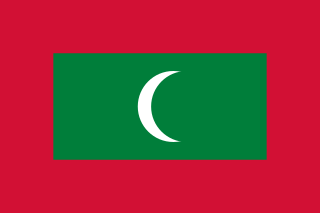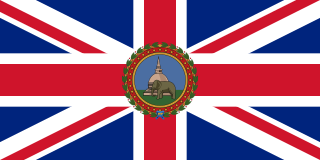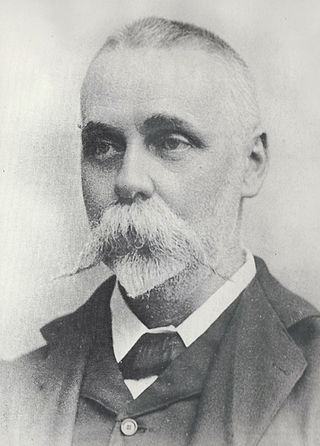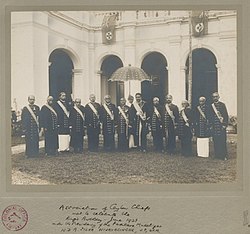
The Maldives, officially the Republic of Maldives, and historically known as the Maldive Islands, is a country and archipelagic state in South Asia in the Indian Ocean. The Maldives is southwest of Sri Lanka and India, about 750 kilometres from the Asian continent's mainland. The Maldives' chain of 26 atolls stretches across the equator from Ihavandhippolhu Atoll in the north to Addu Atoll in the south.

The history of the Maldives is intertwined with the history of the broader Indian subcontinent and the surrounding regions, comprising the areas of South Asia and Indian Ocean. The modern nation is formed of 26 natural atolls, comprising 1194 islands. Historically, the Maldives has held strategic importance due to its location on the major marine routes of the Indian Ocean. The Maldives's nearest neighbors are the British Indian Ocean Territory, Sri Lanka and India. The United Kingdom, Sri Lanka, and some Indian kingdoms have had cultural and economic ties with the Maldives for centuries. In addition to these countries, Maldivians also traded with Aceh and many other kingdoms in what is today Indonesia and Malaysia. The Maldives provided the primary source of cowrie shells, which were then used as currency throughout Asia and parts of the East African coast. Most likely, the Maldives were influenced by the Kalingas of ancient India. The Kalingas were the earliest region of India to trade with Sri Lanka and the Maldives and were responsible for the spread of Buddhism. Stashes of Chinese crockery found buried in various locations in the Maldives also show that there was direct or indirect trade contact between China and the Maldives. In 1411 and 1430, the Chinese admiral Zheng He (鄭和) visited the Maldives. The Chinese also became the first country to establish a diplomatic office in the Maldives when the Chinese nationalist government based in Taipei opened an embassy in Malé in 1966. The Embassy of the People's Republic of China has since replaced this office.

Malé is the capital and most populous city of the Maldives. With a population of 211,908 in 2022 within its administrative area and coterminous geographical area of 8.30 square kilometres (3.20 sq mi), Malé is also one of the most densely populated cities in the world. The city is geographically located in the southern edge of North Malé Atoll.

The governor-general of Ceylon was the representative of the Ceylonese monarch in the Dominion of Ceylon from the country's independence in 1948 until it became the republic of Sri Lanka in 1972.
The Constitution of the Maldives is the supreme law of the country of Maldives. It provides the legal foundation for the existence of the Republic of Maldives, sets out the rights and duties of the citizens of the Maldives, and defines the structure of the Government of the Maldives. The current Constitution of the Maldives was ratified by the then president, Maumoon Abdul Gayyoom, on 7 August 2008, and came into effect immediately, replacing and repealing the Constitution of 1998.

Makunudhoo is one of the inhabited islands of Haa Dhaalu Atoll administrative division and geographically part of Māmakunudhoo Atoll in the north of the Maldives. It is the westernmost inhabited island in the Maldives.

The United Suvadive Republic was a short-lived breakaway state from the Sultanate of Maldives between 1958 and 1963, consisting of the three southern atolls of the Maldive archipelago: Addu Atoll, Huvadhu Atoll and Fuvahmulah. The first president of the new nation was Abdulla Afeef Didi. The secession occurred in the context of the struggle of the Maldives’ emergence as a modern nation. The United Suvadive Republic inherited a Westminster system of governance cloned from the United Kingdom, along with other institutional structures.

The governor of Ceylon was the representative in Ceylon of the British Crown from 1795 to 1948. In this capacity, the governor was president of the Executive Council and Commander-in-Chief of the British Forces in Ceylon. The governor was the head of the British colonial administration in Ceylon, reporting to the Colonial Office.
Maldivian mythology or Maldivian folklore is the body of myths, tales and anecdotes belonging to the oral tradition of Maldivians. Even though some of the Maldivian myths were already mentioned briefly by British commissioner in Ceylon HCP Bell towards the end of the 19th century, their study and publication were carried out only quite recently by Spanish writer and artist Xavier Romero-Frias, at a time when that ancestral worldview was quickly disappearing.

Harry Charles Purvis Bell, CCS, more often known as HCP Bell, was a British civil servant and the first Commissioner of Archaeology in Ceylon.
President's House is the official residence and workplace of the President of Sri Lanka, located at Janadhipathi Mawatha, Colombo, Sri Lanka. Since 1804 it had been the residence of British Governors and Governors-General and was known as the "King's House" or the "Queen's House" until Sri Lanka became a republic in 1972.

The Muliaage palace or Muliaage is the official residence of the president of the Maldives. Muliaage, situated in Henveiru within the historic center of Malé, is located on Medhuziyaarai Magu, near significant landmarks, the Medhu Ziyaaraiy, the Malé Friday Mosque, and the Munnaru.

Lascarins is a term used in Sri Lanka to identify indigenous soldiers who fought for the Portuguese during the Portuguese era (1505–1658) and continued to serve as colonial soldiers until the 1930s. The lascarins played a crucial role not only in the colonial armies, but also in the success of the campaigns of the local kingdoms.

Maldives–Sri Lanka relations, or official and economic relations between the neighbouring Indian Ocean countries of the Maldives and Sri Lanka, have been positive since the Maldives became independent in 1965. The Maldives first established a mission in Sri Lanka in July 1965, and today has a High Commission in Colombo. Sri Lanka has a High Commission in Malé. Both countries were founding members of the South Asian Association for Regional Cooperation (SAARC) in December 1985.

Dom Jerónimo de Azevedo was a Portuguese fidalgo, Governor (captain-general) of Portuguese Ceylon and viceroy of Portuguese India. He proclaimed in Colombo, in 1597, the King of Portugal, Philip I, as the legitimate heir to the throne of Kotte, thus substantiating the Portuguese claims of sovereignty over the island of Ceylon.
Prince Hassan Farid Didi (1901–1944) was a Maldivian royal and a statesman. He was the Minister for Home Affairs, Finance, Minister of State and Plenipotentiary Representative in Ceylon.

The Sultanate of the Maldive Islands was an Islamic monarchy that controlled the Maldives for 815 years (1153–1968), with one interruption from 1953–1954.
Ceylon Hotels Corporation PLC, often called Ceylon Hotels, is a hospitality company in Sri Lanka. The company was incorporated through an Act of the Parliament of Ceylon in 1966. The company was listed as a public company in the following year. Ceylon Hotel Holdings, a subsidiary of Galle Face Hotels Group is the holding company of Ceylon Hotels Corporation. Ceylon Hotels' subsidiary, Kandy Hotels Company owns and operates the Queen's Hotel and the Hotel Suisse heritage hotels.

The Republic of Maldives gained its independence from the United Kingdom, under an agreement signed with United Kingdom on July 26, 1965, after 78 years as a British protectorate.
The High Commission of the Maldives in Sri Lanka is an overseas embassy of the Maldives located in Colombo, the former capital and largest city in Sri Lanka.















